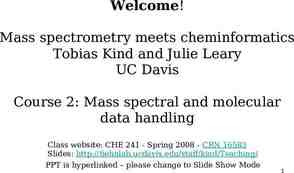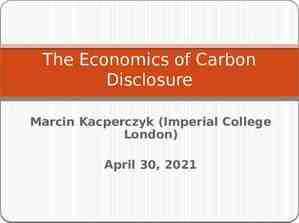Subcommittee for Aviation Safety Report FAA Research, Engineering
17 Slides467.00 KB
Subcommittee for Aviation Safety Report FAA Research, Engineering & Development Advisory Committee October 9, 2014 1
Fall Meeting Sept 10-12, 2014 Atlantic City, NJ FAA Technical Center Full Subcommittee (minus 1) First meeting for new chairman Special Tasking: FY 2017 Guidance Review Emerging and Future Safety Themes 2
Subcommittee Membership Ken Hylander, Chairman Dr. Eric Neiderman, DFO Mark Orr, AVS Chris Benich, Honeywell Dr. John Crowley, US Army Aeromedical Joe Del Balzo, JDA (past subcommittee chair) Walter Desrosier, GAMA Christopher Kmetz, Pratt & Whitney Andrew Lacher, MITRE Capt. James Mangie, Delta Air Lines Douglas Rohn, NASA Todd Sigler, Boeing John White, ALPA 3
REDAC REDAC Strategic Strategic Task Task Ensure a balanced, strategic, and well-integrated R&D portfolio Plan research to meet Administrator’s Strategic Initiatives Task to Subcommittees: – – FY 2017 Guidance Review Look ahead 10 years and develop a list of: Emerging issues (where FAA should get ahead) Future opportunities (where R&D could benefit FAA) 4
Process Subcommittee homework in advance of the meeting Subcommittee member presentations to share their industry segment insights FAA Chief Scientist and Technical Advisor insights FAA leader presentations on research needs identification and guidance process and ongoing continuous improvement 18 presentations Much subcommittee deliberation and debate Summary Report submitted September 24, 2014 5
Meeting Summary FY 2017 Guidance – No Findings or Recommendations Emerging Issues – Real Time System-Wide Safety Assurance – Dependability of Increasingly Complex Systems – Certification of Advanced Materials and Structural technologies – High Density Energy Storage, Management and Use Future Issues for consideration – Commercial Space Integration with the National Space System – General Aviation’s Role in Safety Systems Development – Effects of Breakthrough Medical Technologies on FAA Medical Certification Standards – Identification and Funding of Strategic Research and Development 6
Real-Time Real-Time System-Wide System-Wide Safety Safety Assurance Assurance Why? – Ongoing advances in sensor and network technology, computation, communications and integration – Ongoing advances in data analysis capability – Ongoing developments in accelerated data access – Ongoing data protection issues – Advances in system-on-system modeling and prognostics including integrated human performance monitoring Research Needs Continued development of real time, continuous, safety analysis and assurance tools including; Data mining and analysis Automated prognostics Safety risk modeling Integration of advanced tools into more highly automated safety assurance systems Development of psychological and physiological measures from the human operator that inform the automation Stronger understanding of how human operators and autonomous systems collaborate to improve safety Autonomic properties of self-protection and self-healing 7
Dependability Dependability of of Increasingly Increasingly Complex Complex Systems Systems Software, Automation, and Autonomy – Why? Advances in processing, sensors, networking ongoing Increasingly interconnected and more autonomous systems Continued augmentation of human decision makers with sophisticated systems Require advances in resiliency to design defect, missing or corrupt data and deliberate attack – Research Needs Revisions to certification processes and analytical techniques for verification, validation, test and evaluation (Analytical MoC’s) Ensure that automation on the flight deck and ground systems are designed and implemented in a way to complement the human operator 8
Dependability Dependability of of Increasingly (Continued) Increasingly Complex Complex Systems Systems (Continued) Data Integrity –Why? Exponential growth in volume and distribution of operational data Increased advocacy for uses of data such as expanded aircraft to ground communications Expanded uses of aircraft and engine health monitoring Mix of certified and uncertified (Commercial off the shelf) systems –Research Needs Ensuring the integrity of diverse data from unintentional errors, accidental corruption and deliberate spoofing Regulation and Means of Compliance for the use of Commercial off the Shelf software 9
Dependability Dependability of of Increasingly (continued) Increasingly Complex Complex Systems Systems (continued) Updated Federal Aviation Regulations (FARs) and Means of Compliance – Why? Pace of innovation Existing FARs developed long ago and need reconsideration in light of modern design, development and testing techniques Some prescriptive Means of Compliance may not be producing the desired results Subsystem testing can not always be reliably repeated in full up testing or in flight Blurred lines between aircraft and engine system responsibility – Research Needs Ensure a proactive framework for timely and flexible certification requirements and Means of Compliance to handle near term engine and aircraft architectural advancements Review current and near-term validation technologies and approved methods to ensure use of all adequate techniques and technologies as acceptable Means of Compliance 10
Certification Certification of of Advanced Advanced Materials Materials and and Structural Structural Technologies Technologies Why? – New material systems and structural concepts continue to be introduced Integrated engine and airframe designs – New manufacturing techniques continue to evolve which drive issues of standardization, process variation and uncertainties in failure modes which need to be understood Additive manufacturing – Some traditional inspection processes fall short of reliably being able to catch flaws driving additional work to ensure safety margins Research Needs – Technical methods to stay abreast of changes – Continued evolution towards more performance-based standards – Application of computational material methods (ICME) to streamline the certification process in lieu of physical testing and inspection 11
High-Energy High-Energy Density Density Storage, Storage, Management, Management, and and Use Use Why? – Continued evolution away from traditional electrical systems to improve performance and decrease operating costs – Steady increase in electrical components – More integrated systems and avionics Research Needs – Understand and assess the applicability of various high-energy generation and storage technologies in aviation products and operations – Emphasize developing safe power technology – Provide data for appropriate: Standards and safeguards Implementation, certification and maintenance 12
Commercial Commercial Space Space Integration Integration into into the the NAS NAS Why? Worldwide expansion Growing US industry of both human and cargo space flights Current mechanisms for NAS safety focus on setting up restricted airspace for launch and recovery Current focus on Space Vehicle Occupant safety vs public safety Research Needs Establish necessary guidelines for operational procedures, policies and regulations to protect both vehicle occupants, the public and other aviation operations Increased medical certification standards for passengers and crew of space vehicles Cabin safety and emergency procedures/egress/survival 13
General General Aviation’s Aviation’s Role Role in in Safety Safety Systems Systems Development Development Why? Significant community size Pipeline for qualified pilots and mechanics Unique incubator for introduction of new safety technologies in a timely manner Build on continued emphasis on GA Joint Steering Committee recommendations and preventing loss of control – Situation awareness – Aircraft operational protection – Automation and autonomy that makes it easier to fly in the NAS Research Needs Coordinate with other FAA R&D initiatives and identify safety applications for GA aircraft using safety risk continuum principles to ensure: Appropriate level of rigor Applicability to retrofit and new aircraft applications Rapid installation 14
Effects of Breakthrough Medical Technologies on FAA Medical Certification Standards Why? – Medical science advancing at an unprecedented rate – Ongoing approvals of novel drug therapies and revolutionary surgeries – Historic medical conditions may not now need to end flying careers – Some new medical treatments may pose yet unknown risks to safe flight Research Needs – Support aerospace medicine program to examine effects of emerging medical technologies including: Surveillance of medical research Re-examination of existing medical standards Understanding the effects of new medical developments on performance, safety and certification 15
Identification Identification and and Segregation Segregation of of Strategic Strategic R&D R&D Needs Needs Why? – In the view of the subcommittee, the current research prioritization environment is prone to be: Dominated by known, near-term needs Reactive to unforeseen forces: pop-ups and budget Lacking a consistent, cross-cutting, multi-disciplinary approach to address the remaining known and emerging new safety risks Limiting on true long-term R&D focus and funding Research Needs – FAA conduct research to support the development of a consistent, sustainable, process that is: Rooted in an enterprise view of FAA mandate to promote safety Inclusive of a funding approach that protects the long term R&D needs 16
Conclusions Conclusions The Subcommittee for Aircraft Safety appreciates the FAA’s efforts to keep Research, Engineering & Development focused on the emerging and future needs The subcommittee also appreciates the opportunity to contribute to the process We stand ready to assist in the future Questions? 17






















